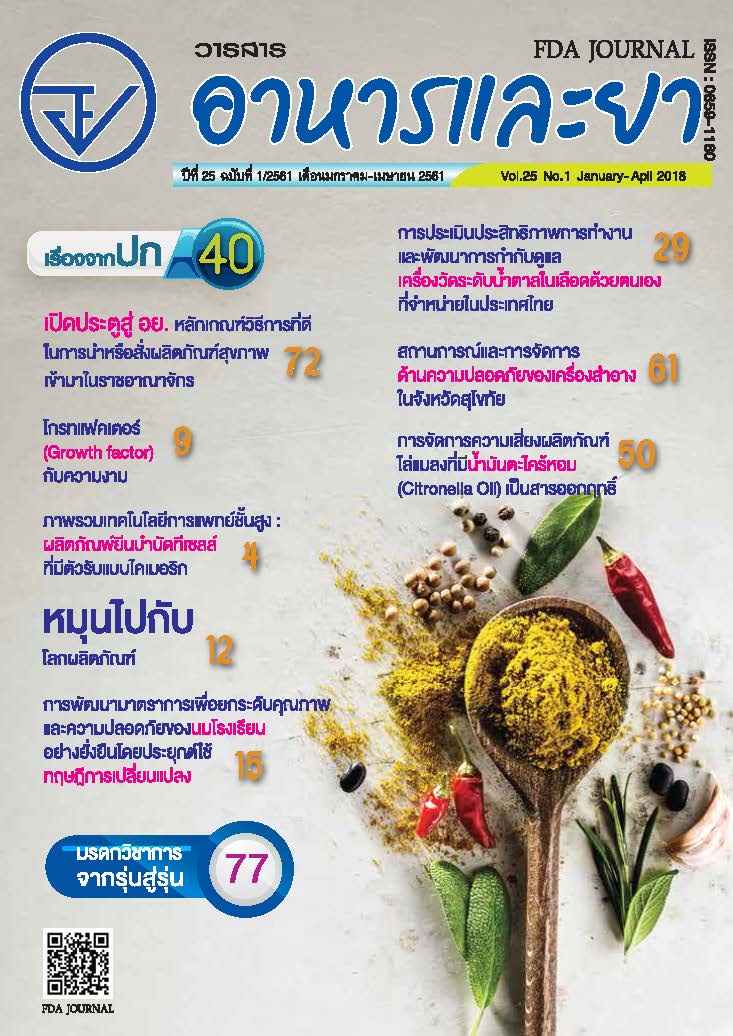สถานการณ์และการจัดการด้านความปลอดภัยของเครื่องสำอางในจังหวัดสุโขทัย
Main Article Content
บทคัดย่อ
การวิจัยเชิงสำรวจเพื่อศึกษาสถานการณ์และการจัดการด้านความปลอดภัยของเครื่องสำอางในจังหวัดสุโขทัย โดยเก็บข้อมูลตั้งแต่ 1 ตุลาคม พ.ศ. 2559 ถึง 30 กรกฎาคม พ.ศ. 2560 การดำเนินการประกอบด้วยการตรวจสถานที่จำหน่ายเครื่องสำอางและร้านเสริมสวยทั้งหมด จำนวน 116 แห่ง และเก็บเครื่องสำอางจำนวน 13,933 ตัวอย่างที่พบในสถานที่ดังกล่าว เพื่อตรวจสอบตามประกาศกระทรวงสาธารณสุข เรื่อง กำหนดลักษณะของเครื่องสำอางที่ห้ามผลิต นำเข้า หรือขาย พ.ศ. 2559 และตรวจสอบความครบถ้วนถูกต้องของการแสดงฉลากตามพระราชบัญญัติเครื่องสำอาง พ.ศ. 2558 มาตรา 22 จากนั้นสุ่มตัวอย่างเครื่องสำอาง เพื่อตรวจสารห้ามใช้โดยชุดทดสอบเบื้องต้นด้วยการเลือกแบบเจาะจงจากเครื่องสำอางที่ไม่ถูกต้องตามกฎหมายดังกล่าวข้างต้น อำเภอละ 3 ตัวอย่าง รวมจำนวน 27 ตัวอย่าง ทั้งมีการตรวจยืนยันผลการตรวจเบื้องต้นโดยห้องปฏิบัติการฯ ของศูนย์วิทยาศาสตร์การแพทย์ที่ 2 พิษณุโลกด้วย ซึ่งการวิเคราะห์ข้อมูลใช้สถิติค่าความถี่และร้อยละ ทั้งนี้ผลการสำรวจ พบว่า มีสถานที่จำนวน 49 แห่ง (ร้อยละ 42.24) ที่ไม่ผ่านเกณฑ์มาตรฐาน โดยพบว่า เป็นร้านที่มีเครื่องสำอางห้ามผลิต นำเข้า หรือขายตามประกาศฯ จำนวน 1 แห่ง (ร้อยละ 0.86) มีเครื่องสำอางที่ฉลากไม่ถูกต้อง จำนวน 40 แห่ง (ร้อยละ 34.48)และร้านที่มีทั้งเครื่องสำอางที่ห้ามผลิต นำเข้าหรือขายตามประกาศฯ และฉลากไม่ถูกต้อง จำนวน 8 แห่ง (ร้อยละ 6.90) นอกจากนี้ ยังพบว่า มีเครื่องสำอางที่ไม่ถูกต้อง จำนวน 275 ตัวอย่าง (ร้อยละ 1.97) โดยเป็นเครื่องสำอางที่มีฉลากไม่ถูกต้อง จำนวน 257 ตัวอย่าง (ร้อยละ 93.45) และเป็นเครื่องสำอางที่ห้าม ผลิต นำเข้า หรือขายตามประกาศฯ 18 ตัวอย่าง (ร้อยละ 6.55) ทั้งนี้เมื่อสุ่มตัวอย่างเครื่องสำอางจำนวน 27 ตัวอย่าง จากจำนวนตัวอย่าง 275 ตัวอย่าง พบว่า มีเครื่องสำอาง จำนวน 18 ตัวอย่าง (ร้อยละ 66.67) ที่ตรวจพบสารห้ามใช้โดยชุดทดสอบเบื้องต้น โดยพบว่า เป็นสารปรอท 12 ตัวอย่าง (ร้อยละ 44.44) ไฮโดรควิโนน 4 ตัวอย่าง (ร้อยละ 14.82) และกรดวิตามินเอ 2 ตัวอย่าง (ร้อยละ 7.41) จึงได้ส่งตัวอย่างทั้ง 18 ตัวอย่างนั้น ส่งตรวจหาสารห้ามใช้เพื่อยืนยันผลโดยห้องปฏิบัติการของศูนย์วิทยาศาสตร์การแพทย์ที่ 2 พิษณุโลก และพบว่า มีเครื่องสำอาง จำนวน 9 ตัวอย่าง (ร้อยละ 33.33) ที่มีสารห้ามใช้ (สารปรอท) ดังนั้นสำนักงานสาธารณสุขจังหวัดจึงควรร่วมมือกับหน่วยงานท้องถิ่นและชุมชนในการเฝ้าระวังเครื่องสำอางที่ไม่ถูกต้องและไม่ปลอดภัย รวมถึงการประชาสัมพันธ์ความรู้เกี่ยวกับเครื่องสำอางอย่างต่อเนื่อง เพื่อให้ประชาชนได้รับความปลอดภัยในการใช้เครื่องสำอาง
Article Details
เอกสารอ้างอิง
2.เนตรนพิศ ประทุม. (2554). ปัจจัยที่มีผลต่อพฤติกรรมการซื้อเครื่องสำอางนำเข้าจากต่างประเทศของเพศที่สาม. ปริญญานิพนธ์ บริหารธุรกิจมหาบัณฑิต วิชาเอกบริหารธุรกิจระหว่างประเทศ คณะบริหารธุรกิจ มหาวิทยาลัยเทคโนโลยีราชมลคลธัญบุรี.
3.รุ่งนภา กงวงษ์, วิบูลย์ วัฒนนามกุล. (2554). การศึกษาพฤติกรรมการใช้ “เครื่องสำอางอันตราย” ของวัยรุ่นหญิง จังหวัดอุบลราชธานี. วารสารเภสัชศาสตร์อีสาน. 7(1), 76-87
4.สิริลักษณ์ รื่นรวย. (2555). การสร้างเครือข่ายงานคุ้มครองผู้บริโภคด้านเครื่องสำอางในชุมชน : กรณีศึกษาตำบลบ้านไร่ อำเภอบ้านไร่ จังหวัดอุทัยธานี. ปริญญานิพนธ์ เภสัชศาสตรมหาบัณฑิต สาขาวิชาการคุ้มครองผู้บริโภคด้านสาธารณสุข บัณฑิตวิทยาลัย มหาวิทยาลัยศิลปากร.
5.พระราชบัญญัติเครื่องสำอาง พ.ศ. 2558. (2558, 9 กันยายน). ราชกิจจานุเบกษา. เล่มที่ 132 ตอนที่ 86ก., หน้า 5.
6.ประกาศกระทรวงสาธารณสุข เรื่อง กำหนดชื่อเครื่องสำอางที่ห้ามผลิต นำเข้า หรือขาย พ.ศ. 2559. (2559, 28 มีนาคม). ราชกิจจานุเบกษา. เล่มที่ 133 ตอนพิเศษ 72ง., หน้า 21.
7.พระราชบัญญัติเครื่องสำอาง พ.ศ. 2558. (2558, 9 กันยายน). ราชกิจจานุเบกษา. เล่มที่ 132 ตอนที่ 86ก., หน้า 11
8.วิสิฐศักดิ์ วุฒิอดิเรกและวชิราภรณ์ พุ่มเกตุ. (2559). การศึกษาปริมาณสารปรอทในครีมทาหน้าที่จำหน่ายในพื้นที่เทศบาลนครนครสวรรค์. วารสารอาหารและยา. 23(1), 28-33.


